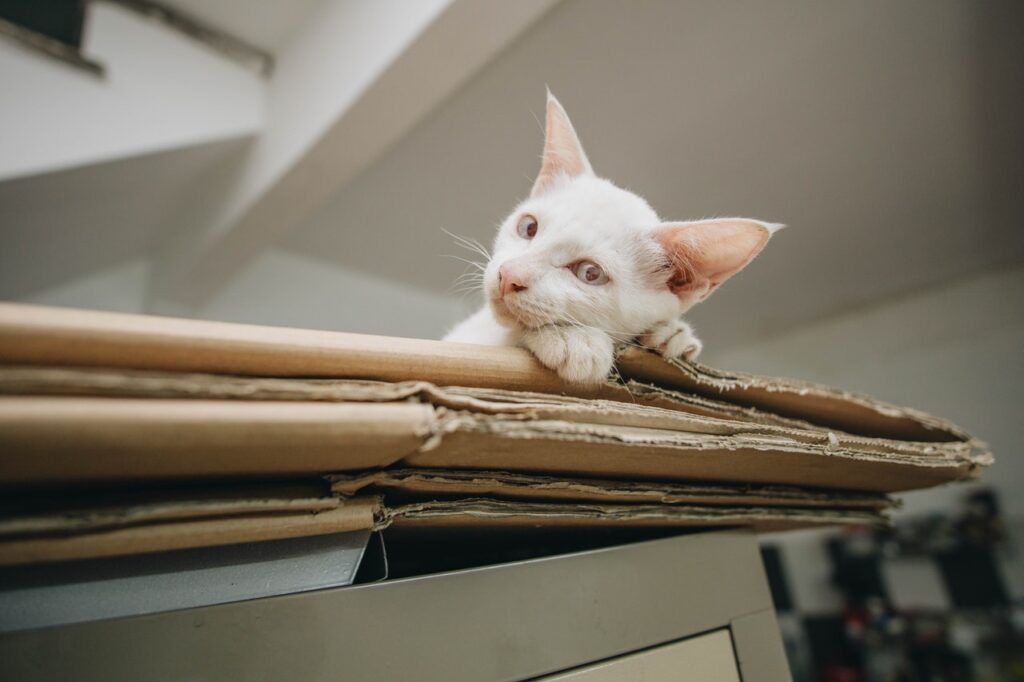We hope you like the products we recommend! Just so you know this post contains affiliate links and I will be compensated if you make a purchase after clicking our links.
Disclaimer
As an Amazon Associate, I earn from qualifying purchases. I get commissions from purchases made through links in this post.
It’s difficult enough relocating adults from one home to another let alone adding pets into the mix, too. Moving house with cats is a daunting prospect for many owners but it doesn’t have to be. With some basic planning and preparation, you and your kitties will be settled into your new place in no time.
What makes moving house with cats difficult is that cats are territorial animals and are bonded to their environment. They don’t like to be picked up and dropped somewhere that doesn’t smell or look familiar. Add to that the fact that most cats don’t like using carriers, and you’ve got a two-pronged problem: moving your felines safely from one place to another and then settling them in at the other end.
Fortunately, cats are resilient creatures and many will settle into their new homes quickly and without too much drama.
We’ve created this short guide to help give you some tips on how to move with a cat so that you can make it as straightforward and as stress-free as possible.
In this article, we’ve included links to products we think are helpful. If you click them and make a purchase, we may receive a small commission at no charge to you.

How to Move with a Cat: Before You Go
Preparation is key and you should start getting ready in advance of moving day.
- Getting your cat used to its carrier is one of the most important things you can do. Carriers can be a huge source of anxiety and stress in felines as so often owners only bring them out for veterinary visits or trips to a cattery. It’s no wonder these boxes cause trepidation and fear. You may have already experienced the hiding and darting away whenever the carrier is brought out of the cupboard. Carrier training isn’t exactly an exciting cat-human activity, but it can be a real game-changer and if you persevere with it stands to make your life so much easier.
- Bring the carrier out into the communal areas of the home where the cat likes to be and leave the door open. You could put familiar smelling bedding or towels inside and a favorite toy or some treats. You could also spray the inside with a cat calming spray or use a wipe to help reduce anxiety (ad). You want your cat to explore its carrier on its own terms so don’t try and shoo it inside but rather put the carrier down and then leave it alone.
- Cats are curious by nature and you may find they start sniffing around, exploring inside and then settling down for a nap. Of course, this may not happen and your cat might refuse to go anywhere near the carrier.
- But it’s still worth leaving it out.
- It means your pet won’t have such a huge shock when it appears out of nowhere on moving day.
- Some cats go full-on banshee at the sight of their carrier and moving day might be approaching too quickly for you to risk stressing them out too much. Do what you think is best for them and yourself and that could mean surprising them moments before they’re due to get inside.
- You know your cat better than anyone but we would suggest you try and acclimatize your kitty to its carrier when you’re in your new home. Just to make life easier for everyone during future trips outside in it. There is a huge range of hard and soft carriers available to buy including pop-up outdoor playpens and backpacks and even strollers with detachable carriers so don’t assume you always have to go for a traditional hard or soft-sided carrier.
- Make sure your cat is micro-chipped and that the details are up-to-date just in case there’s an accidental escape.
- You should register with a vet in your new area, too.
- If you think moving day is going to be too distressing or chaotic for them or if you’re worried about them getting outside in the confusion, you might want to book them into a cattery for a night or two. This gives you one less thing to worry about and it will ensure that the new home is already set-up for them when they arrive.
- If you’re traveling by plane to get to your new home, then double-check your itinerary as well as the airline’s regulations. These can change quickly so don’t rely on second-hand information on the internet but check with the company you’re flying with directly.
- Also, be aware that despite the fact more carriers will say ‘airline approved’, there’s no such thing. The last thing you want is to arrive at the airport to find your crate or carrier isn’t suitable to fly.
- If you’re driving long distance with a cat in the car, then you might want to factor in an overnight break. It’s important to book somewhere that allows pets in the rooms as not all hotels allow cats to stay.
- If you’re moving abroad, then make sure you pack the cat food, litter and biscuits they’re used to: just enough to start them off so they don’t have to get used to new tastes and textures on top of everything else.
- A week or more before the move, you should create a bolt hole for your cats.
- This is just a room where you can put out all of their things: scratching post, litter tray, food bowls, carrier and bedding, etc so that they have a safe place to stay when moving day arrives.
- It’s important to set this up in and the room should remain available to the throughout moving day and be the last thing packed up.
- If you think that it might be especially stressful with the noise and extra foot traffic moving through the house, you could use a plug-in calming diffuser (same idea as the wipes earlier) to create a calming environment.
You can buy Comfort Zone diffusers here (follow the link to visit Amazon).
- You can also gently wipe a soft cloth over the cat’s cheeks and then wipe them on skirting boards and against surfaces in the room to help them feel more comfortable.
- The sudden appearance of boxes and stacked belongings could be stressful to an anxious so bring in the empty boxes and containers gradually so they have a chance to smell and rub their heads about them.
- If you’re able to, keep to the usual routine with feeding and playing. You’ll want to keep things normal for them in the run-up to leaving.
Moving House with Cats: On the Day

- You should bring your cats into the house from the garden. You don’t want to be out searching for them on the very day you’re expecting to leave. Outdoor cats might find this stressful but it’s better to know where they are.
- Situate them in the bolt-home room you prepared (and the one they should now be used to) and put a big note on the door saying the door must be kept shut at all times. Explain to all the removals men and women, too, that they need to stay out of that room.
- If you’re closely bonded to your cats, adding something that smells of you to the room can create a sense of reassurance. It could be a sweater or a jacket.
- Keep to a normal routine for them but feed them light meals if your new home is a long drive away.
- If there’s a lot of noise going on, put a radio or some music on in the room with them.
- Check on them regularly and give them plenty of reassurance and fuss.
- Your cats should be among the last things taken out of the house. Things like litter trays, scratching posts, toys, food bowls, beds and bedding, etc should be packed into the removals truck last of all so that they’re one of the first things to be unpacked at the other side.
- If your truck is arriving later than you are, then pack whatever they’ll need into the car with you. Toys can be useful, too, to help them settle into their new space.
- Leave your contact details with the new owners just in case your cat tries to go back to the previous address.
How to settle a cat after moving house
- Check that the house is cat-proof. Loose kickboards or gaps can provide hiding spots for nervous cats. Make sure the windows are secure and that any cat flaps already installed are locked. Check there are no sharp or broken edges that a cat could injure itself on.
- Set them up in a separate room before you let them out. Make sure the litter box is down along with food and water bowls, beds and scratching posts. Cats can be overwhelmed in big spaces so set up a room for them where they can acclimatize: in a spare bedroom or utility, perhaps.
- If you’ve purchased any plug-in diffusers, add those to the room.
- If the previous owners kept cats in the house, then you’ll want to clean any residual scent away. Deep cleaning is something we all do when we first arrive in a new property but concentrate particularly on the skirting boards and floors and anywhere a cat may have marked its scent.
- For the first few days use litter and food that they’re used to rather than buying new and unfamiliar brands.
- Try and keep to a routine with feeding and playing.
- Make sure there are places in the house where the cats can go high: setting up cat trees or letting them jump up onto surfaces can help them feel more secure in their environment.
- It’s tough keeping outdoor cats inside but you shouldn’t let them out for at least 2-weeks. Cats are territorial and may try to return to a previous property which is dangerous.
- Our vet recommended to us that when we let our cat out we did it just before mealtime so there was an added incentive for her to come back.
Fortunately, she’s very much food motivated so it worked!
What if I’m moving with multiple cats?
Then you’ve got twice, three or even four times the trouble!
Not really, it’s the same principle as with one cat, but the difficulty is sharing your focus between multiple animals. Ask members of the household to focus their attention on an individual cat especially if you think they’re vulnerable.
Kittens, litter-mates or cats that are bonded might be better kept together than left free to roam around the room. Follow this link if you want to shop for pet playpens (many double as carriers).
Is moving house stressful for cats?
It can be.
There are some things we can’t control as owners and if you have an anxious cat then it’s only a case of minimizing their distress. Other cats will take the entire thing in their stride and won’t be bothered at all. All cats react differently, but it’s important to watch their behavior and to reduce any stressors or issues that might pop up along the way.
Planning is important so that you can cover all eventualities.
Additionally, make sure you’re giving them enough fuss and playtime and remember that cats can be very attuned to their owner’s moods so when you’re calmer, hopefully, they’ll be calmer, too.
When should I let my cat outside after moving?
Most advice says to wait between 2 and 3 weeks before letting your cat outside after moving home.
We’d recommend closer to 3 weeks.
It can be difficult to keep outdoor cats inside but it’s for their safety as cats have been known to return to a previous address which can be dangerous. If you have a harness or leash, you can always walk them around the property, and this would help them get used to the smells and sights outside. You can buy harnesses and leashes by clicking through here. You can also buy pop-up cat enclosures for the garden.
Should I put butter on my cat’s paws?
Moving house with cats means you’re almost certain to hear this one.
We’ve heard it time again: if you move house with a cat you should put butter on its paws before letting it out.
It’s an old wives tale but one that many people repeat and swear by. One theory is that if you give a cat something that it likes but never gets, it’s more likely to stick around. Another theory is that saliva on the paws helps the cat lay its scent more effectively.
We’re pretty skeptical. The best thing you can do is to keep your outdoor cats indoors until the 3-weeks are up. Too much fat is bad for cats and we wouldn’t advise adding it to their diet just because you’ve heard it’s a good idea.
What if my cat is depressed after moving?
Depression does exist in cats and it’s something worth keeping an eye on.
Give your pet enough time to settle in. Give them lots of fuss and attention and mental stimulation: the new house is a great excuse for a new toy or even a new playmate.
Outdoor cats might feel sad about not being able to get outside so make sure they can hunt indoors until they’re able to go out again. A window perch or somewhere where they can sit and watch the birds can be helpful. Follow the link if you’d like to buy one. Try and discourage neighborhood cats coming into the garden though, as your cat could become upset or frustrated at a perceived loss of territory.
Once your cat has settled in and feels confident in the environment then its mood should start improving.
If the low mood continues, take the cat to the veterinarian as it could be a sign of a physical problem.
We really hope you’ve found our tips on moving house with cats useful, and we’d like to wish you lots of luck for your upcoming move!

Thank you for sharing wonderful information with us. I did get packing and home removal service from Ledb Ltd Company at very affordable price. I would highly recomended you